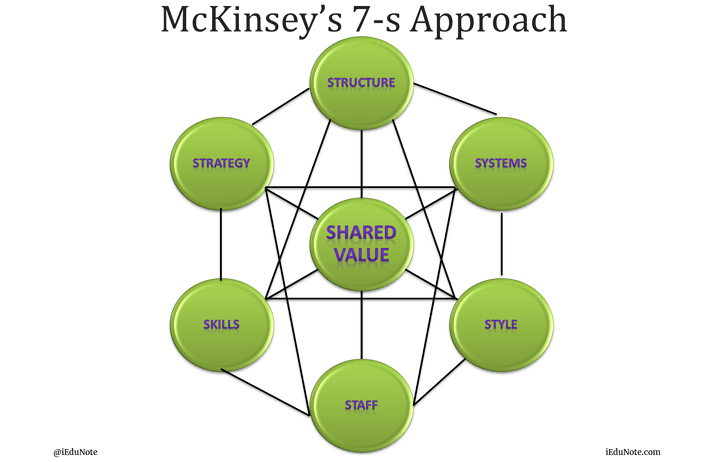McKinsey 7S Framework or Model is used for analyzing management activities of the business and making them as effective as possible for achieving success. McKinsey 7S Framework provides a structure that considers the company as a whole so that the organization’s problems may be identified, analyzed and a strategy may be developed and implemented for tackling it.
The organization’s effectiveness is determined by seven factors whose nomenclature begins with the alphabetic “s” therefore the name 7S. The seven factors are- superordinate goals, strategy, staff, skills, structure, system, shared values, and style. The framework gives equal weight to each of the seven factors and emphasizes the interrelatedness and the “fit” among them.
If the structure does not support the strategy or if the skills are not in consonance with the strategy the fit is reduced and so the effectiveness of the organization.
The 7S framework was a prescriptive framework. It can be used as a tool of internal analysis by drawing up the indicative factors for each of the seven framework elements. The 7S model developed out of the practice of the consulting firm McKinsey.
Consultants at McKinsey & Company developed the 7S Framework or model in the late 1970s to aid managers in addressing difficulties of change in the organization. It was developed and also used during the research work of two bestselling books “The Art of Japanese Management” and “In Search of Excellence”.
The most outstanding fact about the McKinsey 7S Framework is that McKinsey consultants tested extensively in their studies of many companies. Also, At the same time, respected business schools used this framework.
Perhaps the most surprising element about the 7-S model is that it supports and is similar in nature of the managerial functions such as planning, organizing, staffing, leading and controlling.
7 Elements of McKinsey 7S Framework

So the seven elements of McKinsey 7S Framework can be categorized as hard and soft elements.
Hard Elements are Easier for management to identify and influence them. They are more tangible.
Soft elements are difficult for management to identify and influence them; also Intangible and influenced by culture.
- Strategy,
- Structure,
- Systems,
- Shared Values,
- Skills,
- Style, and
- Staff.
1. Strategy
“Strategy” is formulated plans for the organization to reach identified goals. A strategy is the plan to develop long-term advantages.
Competitive advantage derives from meeting customer expectations. The organization examines if the strategy is appropriate and the organization competitive in terms of meeting those expectations.
2. Structure
The hierarchical setting or an organizational structure where and authority and responsibility, relationships are well-defined.
Structure embodies the reporting and accountability relationships within an organization. The structure must support the strategy. The Strategy for electronic retail cannot be met with a functional command and control-based structure.
The organization examines the extent to which the structure facilitates the coordination and cooperation and extent of centralization and decentralization among the different parts of the organization.
3. System
“System’s” refers to the procedures and processes that staff members engage in such as information systems, manufacturing processes, budgeting and control processes; to get the job done.
The system refers to the routines, procedures activities necessary to carry out the operations of the organization.
Every organization derives its strength from some key systems: marketing, finance, production, procurement, human resources, and so on. The other systems perform a strengthening role.
Given the centrality of the system in creating an advantage, are the rules, procedures, and controls adequate?
4. Style
“Style” indicates leadership techniques of management. The way the management behaves to achieve organizational goals.
Leadership can be exercised in the organization in many ways. Style refers to the leadership pattern in the organization.
- Does it motivate and inspire?
- Are the expectations from the employees and the rewards to them balanced?
- Does the leadership and the overall climate foster teamwork?
The style can either reinforce or reduce cross-functional learning and sharing among the organization members.
5. Staff
“Staff” refers to the number and types of employees within the organization.
The people and their capabilities create advantages for the organization. A talent pool and qualitatively superior competencies are the intangible assets on which strategy rides.
A highly specialized competency is difficult to emulate. The organization must consistently seek to find out if the staff is compatible with the changes and if there are any competency gaps.
6. Shared Values
“Shared Values” is the joining center of McKinsey’s model. It refers to the values the members of the organization share. The superordinate goals or shared values signify what we stand for and are the glue that holds the organization together.
They direct the culture of the organization in terms of its work and value ethic. The farther down the organization these are disseminated the greater is the sense of belongingness created among its members. It is similar to strategic intent.
7. Skills
“Skills” refer to the distinctive capabilities of personnel.
As you see, The McKinsey 7S Framework shows the multiplicity interconnected of elements that define an organization’s ability to change.
It changed the manager’s thinking of how companies could be improved. There is no hierarchical chain in the different factors of the McKinsey 7S Framework.
Notice that the “Shared Values” is placed in the middle of the Framework or model. It highlights that values are central to the development of all the other critical elements of the McKinsey 7S Framework.
Entrepreneurs always form the original organization vision. As the values change in an organization, so do all the other elements in it.